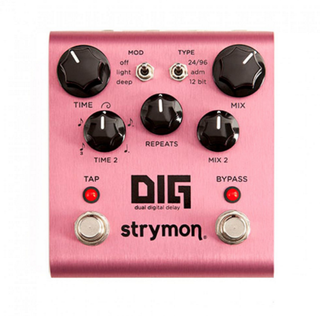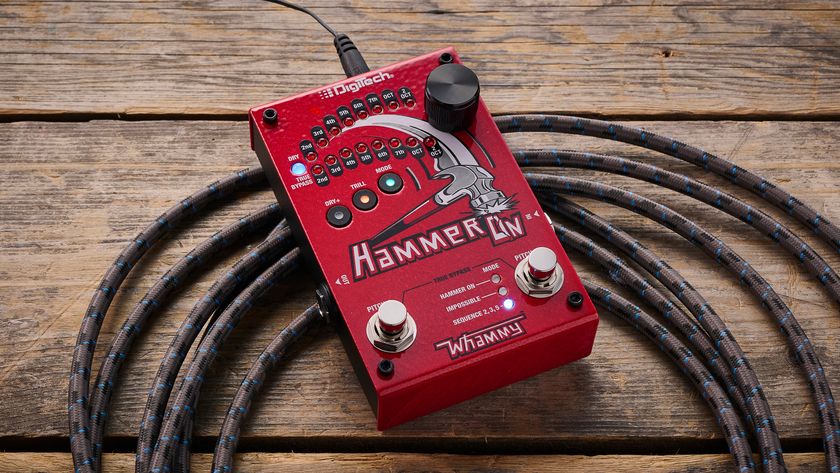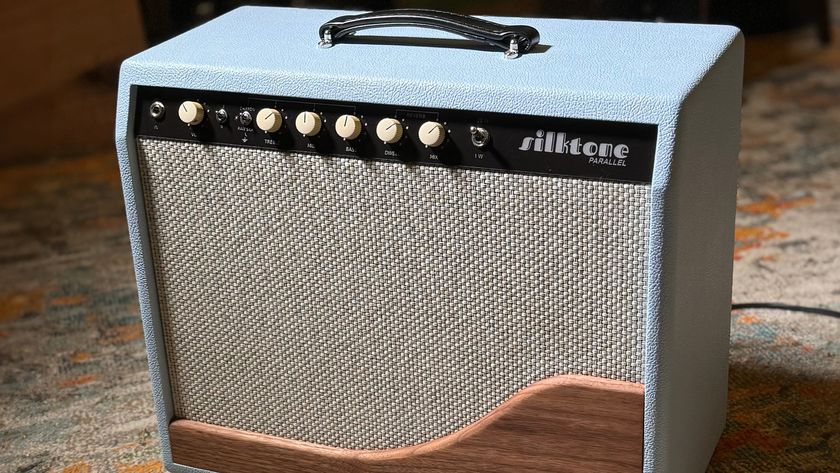Review: Strymon Dig Dual Digital Delay Pedal

GOLD AWARD
Because digital technology has improved exponentially over the last 30 years, most early digital effects are not particularly fondly remembered.
One exception is early digital delay units, particularly studio-quality rack delay units from the early and mid Eighties, which still remain fixtures of numerous pro rigs today (like the Lexicon PCM70 and Roland SDE-3000 units that are still critical components of Eddie Van Halen’s wet/dry/wet setup).
Strymon’s new Dig Dual Digital Delay pedal provides the best of both worlds—the rich, warm, and fat textures of early units and the state-of-the-art clarity, precision, and noise-free performance of today’s technology.
In addition to its capability to function as two separate delay effects, Dig also offers versatile modulation capabilities that create mind-blowing effects that go well beyond those of the average digital delay stomp box.
FEATURES
Dig comes in Strymon’s same “small” format housing as their popular El Capistan and Brigadier delay pedals, but unlike those two analog-inspired products it is an unapologetic digital delay unit. While the pedal has five rotary control knobs and two 3-way switches on its front panel, secondary knob functions are accessed by holding both the tap and bypass footswitches while turning the desired knob.
Get The Pick Newsletter
All the latest guitar news, interviews, lessons, reviews, deals and more, direct to your inbox!
As a result, Dig operates more like a sophisticated rack unit than the average delay pedal. Controls include Time (for delay 1/master or delay 1 subdivisions), Time 2 (subdivisions between delay 1 and 2 or sync/free modes), Mix (wet/dry ratio for delay 1 or filter functions), Mix 2 (wet/dry ratio for delay 2 or series/ping pong/parallel configurations), and Repeats (repeats for both delays or delay 2 repeats only). The Modulation switch provides off, light, and deep settings, and the Type switch allows users to select 24/96 (modern 24-bit/96kHz processing), adm (early Eighties adaptive delta modulation), or 12-bit (mid Eighties 12-bit processing).
Separate footswitches control bypass and tap tempo functions. Separate left and right output jacks provide stereo effects (or enable Dig to function as two individual delay units in parallel processing settings, ideal for wet/dry/wet rigs), and an expression pedal jack allows guitarists to manually control any desired parameter, engage tap tempo with a remote switch, or use Strymon’s Favorite switch to recall desired effects. While Dig has only one input jack, it can function as a stereo input using a TRS cable and by engaging an internal switch.
PERFORMANCE
I’ve steadfastly kept my old 12-bit rack digital delays in my rig because I love how fat and warm they sound with guitar, but Dig is the first digital delay pedal I’ve tried that has tempted me to sell those bulky pieces of gear once and for all. The adm and 12-bit settings absolutely nail the elusive character of Eighties digital delay units, but without the aliasing noise and less-than-desirable signal-to-noise ratio of many early digital effects. Dig is absolutely noise free, and it sounds equally great with clean or heavily distorted high-gain tones.
Even better is the wide variety of chorus, flanging, and trippy modulation effects that this pedal offers, which all sound vibrant and lush. Dialing in these effects can take some patience and experimentation, but fortunately Strymon offers several helpful examples to familiarize guitarists with the pedal’s immense capabilities.
The optional Favorite switch is highly recommended for saving any effects you want to replicate later, plus it enables Dig to function as two separate effect pedals. The only feature I miss is an LED that displays the exact delay time settings, but the tap tempo function almost always got me the setting I wanted, and usually it’s better to rely on one’s ears anyway.
STREET PRICE $299
MANUFACTURER Strymon, strymon.net
•Series, parallel, and ping-pong configurations plus the ability to link or operate the two digital delay sections separately provides a wide variety of functions and effects.
•Delay types include modern (24/96) or classic Eighties (adm or 12-bit), and versatile modulation capabilities provide lush chorus and flanging effects.
THE BOTTOM LINE Ideal for guitarists who love the fat, warm tones of Eighties digital processors as well as the precision and clarity of modern, state-of-the-art delay effects, the Strymon Dig is an incredibly versatile digital delay pedal for delay connoisseurs.
Chris is the co-author of Eruption - Conversations with Eddie Van Halen. He is a 40-year music industry veteran who started at Boardwalk Entertainment (Joan Jett, Night Ranger) and Roland US before becoming a guitar journalist in 1991. He has interviewed more than 600 artists, written more than 1,400 product reviews and contributed to Jeff Beck’s Beck 01: Hot Rods and Rock & Roll and Eric Clapton’s Six String Stories.

“All of a sudden, my occasional-use pedal has gone to something that can live on the ’board”: That Pedal Show’s Mick Taylor sparks inspired change that sees the Argo Boost Deluxe serve octave fuzz and boost tones in one unit

“It can make you a legato monster like Satch, give you EVH-level tapping skills, or turn your guitar into a synth sequencer”: DigiTech HammerOn review










